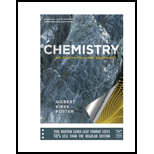
To find:
Mean and standard deviation.
Answer to Problem 1.68QA
Solution:
For manufacturer 3 value of confidence interval at 95% equals 0.500 μm.
The values for manufacturer 3 are precise and accurate as they are a good match with the actual value and they are also close to each other.
Manufacturer 2 is precise but not accurate as their values are very close to each other but are not close to the actual value.
Explanation of Solution
Formula:
We have formula for mean as follows;
We are given the three widths of copper lines on circuit boards from three manufacturers. The mean line width of the three manufacturers’ boards is calculated as:
The formula to calculate the standard deviation is as follows;
Here Xi is the individual value for the five different sets, X is the mean, and N is the number of samples.
So we can calculate the standard deviation for the manufacturer 1 as follows,
| Manufacturer 1 | (Xi – X) | (Xi-X)2 |
| 0.512 | 0.0014 | 1.96* 10^-6 |
| 0.508 | -0.0026 | 6.76*10^-6 |
| 0.516 | 0.0054 | 2.916*10^-5 |
| 0.504 | -0.0066 | 4.356*10^-5 |
| 0.513 | 0.0024 | 5.76*10^-6 |
| Mean | 1.744* 10^-6 | |
Plug in the values in our formula for standard deviation as below,
This is the standard deviation for the first manufacturer.
From standard deviation we can find how much precise the data is.
So to calculate the accuracy we have to use the formula for the confidence interval and it is as follows:
Where X is the mean, S the standard deviation, ‘t’ a fixed value which is 2.776 for 95% of confidence interval at (n-1) = 4, and ‘n’ the number of samples.
For manufacturer 2:
We have formula for mean as follows;
So we have given the three values of circuit boards of copper lines so we can calculate the mean of the three different manufacturers as below,
The formula to calculate the standard deviation is as follows;
Here Xi is the values for the five different sets and X is the mean and N are the total number of samples.
So we can calculate the standard deviation for the manufacturer 2 as follows,
| Manufacturer 2 | (Xi – X) | (Xi-X)2 |
| 0.514 | 0.0006 | 3.6* 10^-7 |
| 0.513 | -0.0004 | 1.6* 10^-7 |
| 0.514 | 0.0006 | 3.6* 10^-7 |
| 0.514 | 0.0006 | 3.6* 10^-7 |
| 0.512 | -0.0014 | 1.96*10^-6 |
| Mean | 6.4 10^-7 | |
So plug in the value in our formula for standard deviation as below,
This is the standard deviation for the first manufacturer.
From standard deviation we can find how much precise the data is.
So to calculate the accuracy we have to use the formula for the confidence interval and it is as follows:
Where X is the mean, S the standard deviation, ‘t’ a fixed value which is 2.776 for 95% of confidence interval at (n-1) = 4, and ‘n’ the number of samples.
For manufacturer 3:
We have formula for mean as follows;
We are given the three values of circuit boards of copper lines, so we can calculate the mean of the three different manufacturers as
The formula to calculate the standard deviation is as follows;
Here Xi are the values for the five different sets, X the mean, and N the total number of samples.
So we can calculate the standard deviation for the manufacturer 3 as follows:
| Manufacturer 3 | (Xi – X) | (Xi-X)2 |
| 0.50 | -0..0012 | 1.44* 10^-6 |
| 0.501 | -0.0002 | 0.4*10^-7 |
| 0.502 | 0.0008 | 6.4*10^-7 |
| 0.502 | 0.0008 | 6.4*10^-7 |
| 0.501 | -0.0002 | 0.4*10^-7 |
| Mean | 5.6*10^-7 | |
So plug in the value in our formula for standard deviation as below,
This is the standard deviation for the first manufacturer.
From standard deviation we can find how much precise the data is.
So to calculate the accuracy we have to use the formula for the confidence interval and it is as follows:
Where X is the mean, S the standard deviation, ‘t’ a fixed value which is 2.776 for 95% of confidence interval at (n-1) = 4, and ‘n’ the number of samples.
Conclusion:
For manufacture 3 value of confidence interval at 95% equals 0.500 μm.
The values for manufacturer 3 are precise and accurate as the values match the actual value and they are also close to each other.
Manufacturer 2 is precise but not accurate as the values they got are very close to each other but are not close to the actual value.
Want to see more full solutions like this?
Chapter 1 Solutions
Chemistry: An Atoms-Focused Approach
 ChemistryChemistryISBN:9781305957404Author:Steven S. Zumdahl, Susan A. Zumdahl, Donald J. DeCostePublisher:Cengage Learning
ChemistryChemistryISBN:9781305957404Author:Steven S. Zumdahl, Susan A. Zumdahl, Donald J. DeCostePublisher:Cengage Learning ChemistryChemistryISBN:9781259911156Author:Raymond Chang Dr., Jason Overby ProfessorPublisher:McGraw-Hill Education
ChemistryChemistryISBN:9781259911156Author:Raymond Chang Dr., Jason Overby ProfessorPublisher:McGraw-Hill Education Principles of Instrumental AnalysisChemistryISBN:9781305577213Author:Douglas A. Skoog, F. James Holler, Stanley R. CrouchPublisher:Cengage Learning
Principles of Instrumental AnalysisChemistryISBN:9781305577213Author:Douglas A. Skoog, F. James Holler, Stanley R. CrouchPublisher:Cengage Learning Organic ChemistryChemistryISBN:9780078021558Author:Janice Gorzynski Smith Dr.Publisher:McGraw-Hill Education
Organic ChemistryChemistryISBN:9780078021558Author:Janice Gorzynski Smith Dr.Publisher:McGraw-Hill Education Chemistry: Principles and ReactionsChemistryISBN:9781305079373Author:William L. Masterton, Cecile N. HurleyPublisher:Cengage Learning
Chemistry: Principles and ReactionsChemistryISBN:9781305079373Author:William L. Masterton, Cecile N. HurleyPublisher:Cengage Learning Elementary Principles of Chemical Processes, Bind...ChemistryISBN:9781118431221Author:Richard M. Felder, Ronald W. Rousseau, Lisa G. BullardPublisher:WILEY
Elementary Principles of Chemical Processes, Bind...ChemistryISBN:9781118431221Author:Richard M. Felder, Ronald W. Rousseau, Lisa G. BullardPublisher:WILEY





